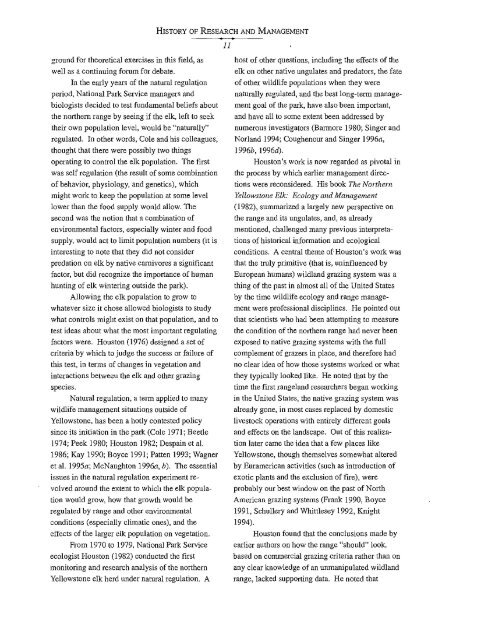Yellowstone's Northern Range - Greater Yellowstone Science ...
Yellowstone's Northern Range - Greater Yellowstone Science ...
Yellowstone's Northern Range - Greater Yellowstone Science ...
You also want an ePaper? Increase the reach of your titles
YUMPU automatically turns print PDFs into web optimized ePapers that Google loves.
HISTORY OF RESEARCH AND MANAGEMENT<br />
11<br />
ground for theoretical exercises in this field, as<br />
well as a continuing forum for debate.<br />
In the early years of the natural regulation<br />
period, National Park Service managers and<br />
biologists decided to test fundamental beliefs about<br />
the northern range by seeing if the elk, left to seek<br />
their own population level, would be "naturally"<br />
regulated. In other words, Cole and his colleagues,<br />
thought that there were possibly two things<br />
operating to control the elk population. The first<br />
was self regulation (the result of some combination<br />
of behavior, physiology, and genetics), which<br />
might work to keep the population at some level<br />
lower than the food supply would allow. The<br />
second was the notion that a combination of<br />
environmental factors, especially winter and food<br />
supply, would act to limit population numbers (it is<br />
interesting to note that they did not consider<br />
predation on elk by native carnivores a significant<br />
factor, but did recognize the importance of human<br />
hunting of elk wintering outside the park).<br />
Allowing the elk population to grow to<br />
whatever size it chose allowed biologists to study<br />
what controls might exist on that population, and to<br />
test ideas about what the most important regulating<br />
factors were. Houston (1976) designed a set of<br />
criteria by wbich to judge the success or failure of<br />
this test, in tefms of changes in vegetation and<br />
interactions between the elk and other grazing<br />
species.<br />
Natural regulation, a term applied to many<br />
wildlife management situations outside of<br />
<strong>Yellowstone</strong>, has been a hotly contested policy<br />
since its initiation in the park (Cole 1971; Beetle<br />
1974; Peek 1980; Houston 1982; Despain et a1.<br />
1986; Kay 1990; Boyce 1991; Patten 1993; Wagner<br />
et a1. 1995a; McNaughton 1996a, b). The essential<br />
issues in the natural regulation experiment revolved<br />
around the extent to which the elk population<br />
would grow, how that growth would be<br />
regulated by range and other environmental<br />
conditions (especially climatic ones), and the<br />
effects of the larger elk popUlation on vegetation.<br />
From 1970 to 1979, National Park Service<br />
ecologist Houston (1982) conducted the first<br />
monitoring and research analysis of the northern<br />
<strong>Yellowstone</strong> elk herd under natural regulation. A<br />
host of other questions, including the effects of the<br />
elk on other native ungulates and predators, the fate<br />
of other wildlife populations when they were<br />
naturally regulated, and the best long-term management<br />
goal of the park, have also been important,<br />
and have all to some extent been addressed by<br />
numerous investigators (Barmore 1980; Singer and<br />
Norland 1994; Coughenour and Singer 1996a,<br />
1996b,1996d).<br />
Houston's work is now regarded as pivotal in<br />
the process by which earlier management directions<br />
were reconsidered. His book The <strong>Northern</strong><br />
<strong>Yellowstone</strong> Elk: Ecology and Management<br />
(1982), summarized a largely new perspective on<br />
the range and its ungulates, and, as already<br />
mentioned, challenged many previous interpretations<br />
of historical information and ecological<br />
conditions. A central theme ofBauston's work was<br />
that the truly primitive (that is, uninfluenced by<br />
European humans) wildland grazing system was a<br />
thing of the past in almost all of the United States<br />
by the time wildlife ecology and range management<br />
were professional disciplines. He pointed out<br />
that scientists who had been attempting to measure<br />
the condition of the northern range had never been<br />
exposed to native grazing systems with the full<br />
complement of grazers in place, and therefore had<br />
no clear idea of how those systems worked or what<br />
they typically looked like. He noted that by the<br />
time the first rangeland researchers began working<br />
in the United States, the native grazing system was<br />
already gone, in most cases replaced by domestic<br />
livestock operations with entirely different goals<br />
and effects on the landscape. Out of this realization<br />
later came the idea that a few places like<br />
<strong>Yellowstone</strong>, though themselves somewhat altered<br />
by Euramerican activities (such as introduction of<br />
exotic plants and the exclusion offire), were<br />
probably our best window on the past of North<br />
American grazing systems (Frank 1990, Boyce<br />
1991, Schullery and Whittlesey 1992, Knight<br />
1994).<br />
Houston found that the conclusions made by<br />
earlier authors on how the range "should" look,<br />
based on commercial grazing criteria rather than on<br />
any clear knowledge of an unmanipulated wildland<br />
range, lacked supporting data. He noted that















